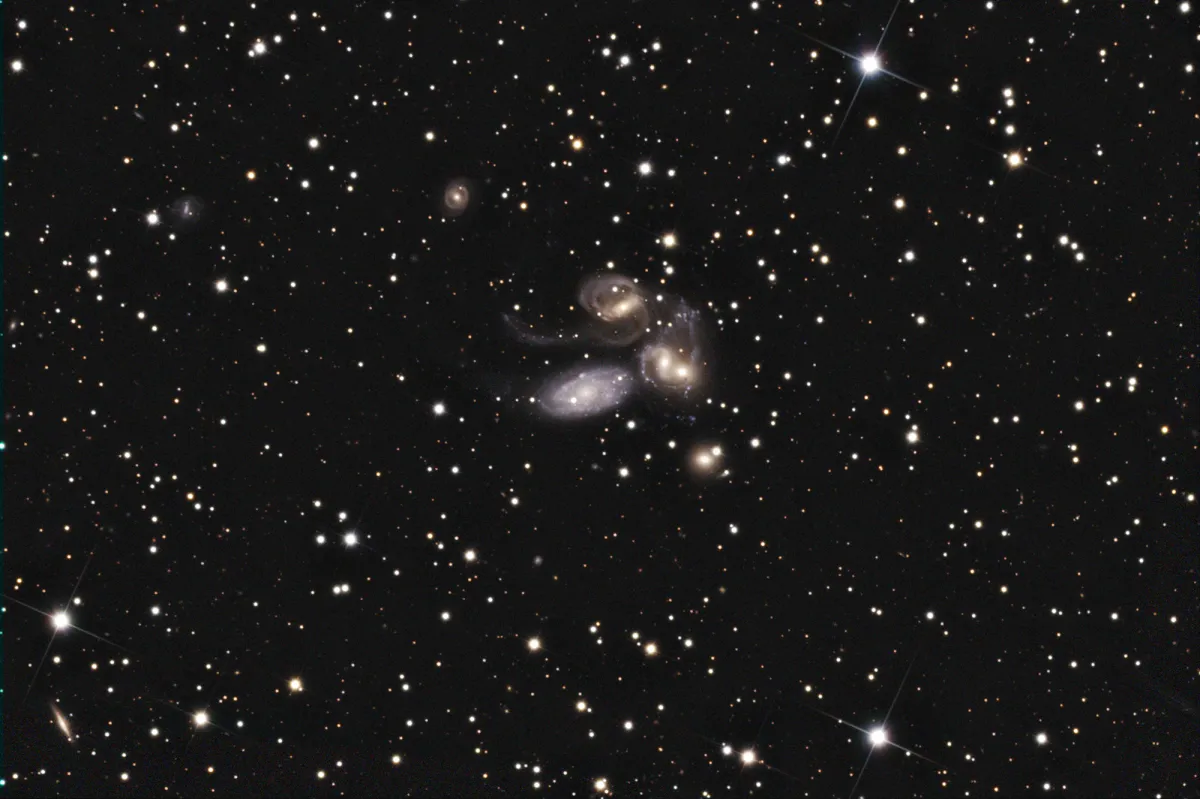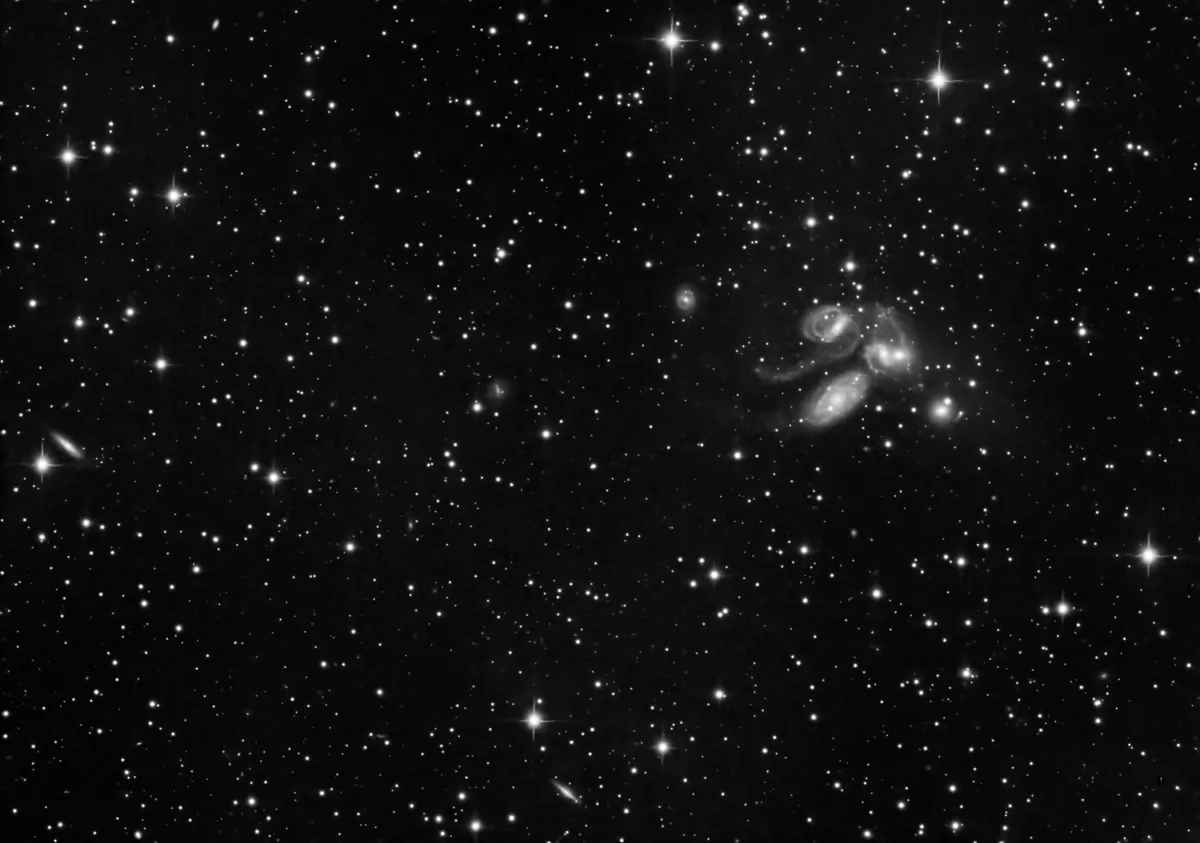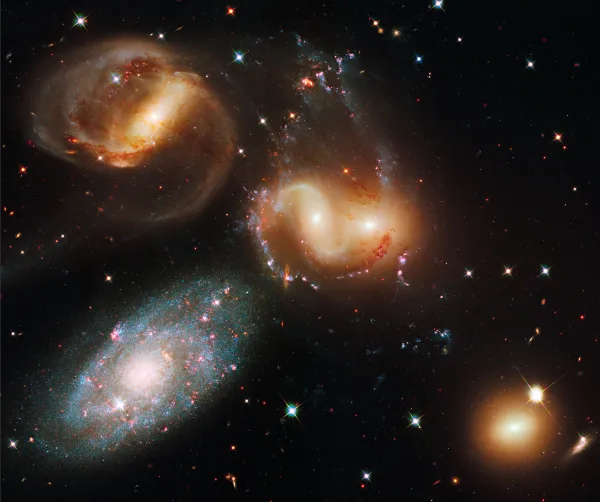Stephans Quintet (Hickson 92)



History
This compact group of galaxies was the first to be discovered. It was first sighted by the French astronomer Jean Marie Édouard Stephan in 1876. From 1866 to 1907 he was director of the observatory in Marseille. At that time, however, he only saw four nebulae and wrote: «The four nebulae 19, 20, 21 and 22 are very, very faint, very small and difficult to observe. The most beautiful is 19, then 20, 21, 22. Although 22 is the smallest of the four, it is the brightest.» [420]
The four nebulae were included in 1888 by the Danish-Irish astronomer Johann (John) Louis Emil Dreyer as NGC 7317, NGC 7318, NGC 7319, NGC 7320 in his «New General Catalogue of Nebulae and Clusters of Stars». [313] Stephan's former quartet became a quintet when NGC 7318 emerged as two galaxies and were henceforth called NGC 7318A and NGC 7318B. The American astronomer Halton Arp listed this group under the name Arp 319 in his 1966 «Atlas of Peculiar Galaxies» as an example of a group of galaxies. [199]

Paul Hickson lists this group of galaxies in his 1993 «Atlas of Compact Groups of Galaxies" as HCG 92. He wrote: «This is the famous group of Stephan's Quintet, also Arp 319 and VV 228. It consists of a compact quartet plus a bright, lower redshift, spiral galaxy (NGC 7320). The quartet has a relatively high velocity dispersion and a short crossing time. The distorted galaxy (NGC 7319) is an infrared and radio source.» [166]
Physical Properties
The brightest and largest galaxy in this quintet is NGC 7320. It does not belong to the group, but has a much smaller redshift and is in the foreground at a distance of about 14-18 Mpc, while the other galaxies are about 90-97 Mpc. [145] It is believed that it could be the physical companion of the larger galaxies NGC 7331, which is roughly the same distance away. A little further east is another small galaxy: NGC 7320C. It is about the same distance as the other galaxies and actually belongs to the group. All members of this group show gravitational interactions with one another. Kinematic studies showed that NGC 7320C and NGC 7318B invaded the group and created the tidal arms. [422]
| Name | RA | Dec | Type | bMag | vMag | B-V | SB | Dim | PA | z | D(z) | MD | Dreyer Description | Identification, Remarks |
|---|---|---|---|---|---|---|---|---|---|---|---|---|---|---|
| NGC 7317 | 22 35 51.9 | +33 56 43 | Gx (E4) | 14.6 | 13.6 | 1.0 | 13.8 | 0.4 × 0.4 | 0.022012 | 92.98 | vF, vS | GC 6061; MCG 6-49-38; CGCG 514-60; VV 288; Arp 319; HCG 92E; Stephan's quintet | ||
| NGC 7318 A | 22 35 56.7 | +33 57 58 | Gx (E2/P) | 14.3 | 13.4 | 0.9 | 13.1 | 1.2 × 1 | 5 | 0.022115 | 93.41 | eF, eS | GC 6062; UGC 12099; MCG 6-49-39; CGCG 514-61; VV 288; Arp 319; ARAK 560; HCG 92D; NPM1G +33.0464; Stephan's quintet | |
| NGC 7318 B | 22 35 58.3 | +33 58 00 | Gx (SBbc) | 14.0 | 13.1 | 0.9 | 13.2 | 1.6 × 1.1 | 99 | 0.019260 | 81.35 | eF, eS | GC 6062; UGC 12100; MCG 6-49-40; CGCG 514-62; Arp 319; VV 288; HCG 92B; NPM1G +33.0464; Stephan's quintet | |
| NGC 7319 | 22 36 03.5 | +33 58 35 | Gx (SBbc) | 14.1 | 13.1 | 1.0 | 13.8 | 1.4 × 1.1 | 52 | 0.022507 | 95.07 | eF, eS | GC 6063; UGC 12102; MCG 6-49-41; CGCG 514-64; IRAS 22337+3342; NPM1G +33.0466; HCG 92C; Arp 319; VV 288; Stephan's quintet | |
| NGC 7320 | 22 36 03.5 | +33 56 54 | Gx (Scd) | 13.2 | 12.6 | 0.6 | 13.5 | 2.2 × 1.1 | 132 | 0.002622 | 11.08 | 15.670 | F, vS | GC 6064; UGC 12101; MCG 6-49-42; CGCG 514-63; VV 288; Arp 319; HCG 92A; Stephan's quintet |
| NGC 7320 A | 22 36 32.2 | +33 47 46 | Gx (S0) | 16.0 | 15.0 | 1.0 | 12.1 | 0.4 × 0.2 | 45 | F, vS | GC 6064 | |||
| NGC 7320 B | 22 37 28.1 | +33 55 24 | Gx (S) | 15.6 | 14.8 | 0.8 | 12.3 | 0.6 × 0.2 | 50 | 0.021278 | 89.88 | F, vS | GC 6064; CGCG 514-72 | |
| NGC 7320 C | 22 36 20.3 | +33 59 08 | Gx (SB0-a) | 16.7 | 15.5 | 1.2 | 13.4 | 0.6 × 0.4 | 172 | 0.019964 | 84.33 | F, vS | GC 6064; MCG 6-49-43; NPM1G +33.0467; Member of Stephan's quintet? |
Finder Chart
The galaxy group is located in the constellation Pegasus. The larger and brighter galaxy NGC 7331 can be used as a search aid. Stephen's quintet is only half a degree southwest of it. On 31 August it is in opposition to the Sun and crosses the meridian at local midnight. The best observation time is May to January.
Visual Observation
762 mm Öffnung: The five galaxies listed as Stephen's Quintet, NGC 7317, NGC 7318A, NGC 7318B, NGC 7319 and NGC 7320, are easily recognizable. The sixth galaxy in the group, NGC 7320C (PGC 69279), can be found and verified by means of the surrounding stars. — 30" f/3.3 Slipstream Dobsonian, Hasliberg, 26. 10. 2019, SQM 21.17, Eduard von Bergen
762 mm Aperture: All five members of Stephen's quintet (NGC 7317, 7318A, 7318B, 7319, 7320) were clearly visible. A more detailed description was omitted due to advanced tiredness in the early morning hour. — 30" Slipstream Dobsonian, Hasliberg, 14. 8. 2021 Bernd Nies, Eduard von Bergen
